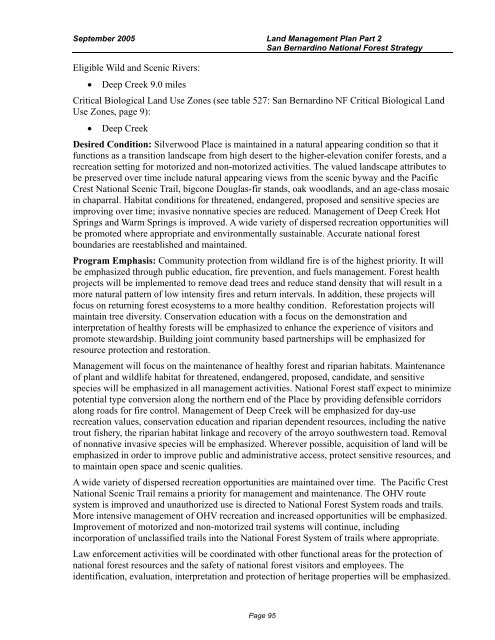San Bernardino National Forest Land Management Plan - Part 2
San Bernardino National Forest Land Management Plan - Part 2
San Bernardino National Forest Land Management Plan - Part 2
Create successful ePaper yourself
Turn your PDF publications into a flip-book with our unique Google optimized e-Paper software.
September 2005 <strong>Land</strong> <strong>Management</strong> <strong>Plan</strong> <strong>Part</strong> 2<br />
<strong>San</strong> <strong>Bernardino</strong> <strong>National</strong> <strong>Forest</strong> Strategy<br />
Eligible Wild and Scenic Rivers:<br />
• Deep Creek 9.0 miles<br />
Critical Biological <strong>Land</strong> Use Zones (see table 527: <strong>San</strong> <strong>Bernardino</strong> NF Critical Biological <strong>Land</strong><br />
Use Zones, page 9):<br />
• Deep Creek<br />
Desired Condition: Silverwood Place is maintained in a natural appearing condition so that it<br />
functions as a transition landscape from high desert to the higher-elevation conifer forests, and a<br />
recreation setting for motorized and non-motorized activities. The valued landscape attributes to<br />
be preserved over time include natural appearing views from the scenic byway and the Pacific<br />
Crest <strong>National</strong> Scenic Trail, bigcone Douglas-fir stands, oak woodlands, and an age-class mosaic<br />
in chaparral. Habitat conditions for threatened, endangered, proposed and sensitive species are<br />
improving over time; invasive nonnative species are reduced. <strong>Management</strong> of Deep Creek Hot<br />
Springs and Warm Springs is improved. A wide variety of dispersed recreation opportunities will<br />
be promoted where appropriate and environmentally sustainable. Accurate national forest<br />
boundaries are reestablished and maintained.<br />
Program Emphasis: Community protection from wildland fire is of the highest priority. It will<br />
be emphasized through public education, fire prevention, and fuels management. <strong>Forest</strong> health<br />
projects will be implemented to remove dead trees and reduce stand density that will result in a<br />
more natural pattern of low intensity fires and return intervals. In addition, these projects will<br />
focus on returning forest ecosystems to a more healthy condition. Reforestation projects will<br />
maintain tree diversity. Conservation education with a focus on the demonstration and<br />
interpretation of healthy forests will be emphasized to enhance the experience of visitors and<br />
promote stewardship. Building joint community based partnerships will be emphasized for<br />
resource protection and restoration.<br />
<strong>Management</strong> will focus on the maintenance of healthy forest and riparian habitats. Maintenance<br />
of plant and wildlife habitat for threatened, endangered, proposed, candidate, and sensitive<br />
species will be emphasized in all management activities. <strong>National</strong> <strong>Forest</strong> staff expect to minimize<br />
potential type conversion along the northern end of the Place by providing defensible corridors<br />
along roads for fire control. <strong>Management</strong> of Deep Creek will be emphasized for day-use<br />
recreation values, conservation education and riparian dependent resources, including the native<br />
trout fishery, the riparian habitat linkage and recovery of the arroyo southwestern toad. Removal<br />
of nonnative invasive species will be emphasized. Wherever possible, acquisition of land will be<br />
emphasized in order to improve public and administrative access, protect sensitive resources, and<br />
to maintain open space and scenic qualities.<br />
A wide variety of dispersed recreation opportunities are maintained over time. The Pacific Crest<br />
<strong>National</strong> Scenic Trail remains a priority for management and maintenance. The OHV route<br />
system is improved and unauthorized use is directed to <strong>National</strong> <strong>Forest</strong> System roads and trails.<br />
More intensive management of OHV recreation and increased opportunities will be emphasized.<br />
Improvement of motorized and non-motorized trail systems will continue, including<br />
incorporation of unclassified trails into the <strong>National</strong> <strong>Forest</strong> System of trails where appropriate.<br />
Law enforcement activities will be coordinated with other functional areas for the protection of<br />
national forest resources and the safety of national forest visitors and employees. The<br />
identification, evaluation, interpretation and protection of heritage properties will be emphasized.<br />
Page 95
















